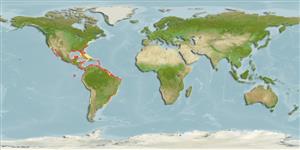Пластиножаберные (акулы и скаты) (sharks and rays) >
Carcharhiniformes (Ground sharks) >
Sphyrnidae (Hammerhead, bonnethead, or scoophead sharks)
Etymology: Sphyrna: Probable misspelling of sphyra (Gr.), hammer, referring to their hammer-shaped heads. (See ETYFish); tiburo: Latin for western, an eastern Pacific relative of the Western Atlantic S. tiburo. (See ETYFish).
More on author: Linnaeus.
Environment: milieu / climate zone / depth range / distribution range
экология
морской; солоноватоводный ассоциированный с рифами; пределы глубины 10 - 80 m (Ref. 244), usually 10 - 25 m (Ref. 9253). Subtropical; 45°N - 36°S, 121°W - 32°W (Ref. 55302)
Western Atlantic: North Carolina, USA to southern Brazil, including Cuba and the Bahamas. Caribbean and Gulf of Mexico; rare in Bermuda (Ref. 26938). Eastern Pacific: southern California, USA to Ecuador.
Length at first maturity / Size / Вес / Возраст
Maturity: Lm 85.0, range 80 - 90 cm
Max length : 150 cm TL самец/пол неопределен; (Ref. 5217); common length : 80.0 cm TL самец/пол неопределен; (Ref. 5217); наибольший вес (опубликованные данные): 10.8 kg (Ref. 40637); наибольший возраст (опубликованны данные): 12 годы (Ref. 26248)
Front of head semicircular in outline. No other hammerhead has front of head in semicircle. (Ref. 26938).
Found on the continental and insular shelves, on inshore and coastal areas, over mud and sand bottoms, also on coral reefs. Often occur in shallow water including estuaries, shallow bays and over coral reefs (Ref. 9987). Spends night time hours on shallow grass flats, searching for nocturnally active invertebrate prey, moves into deeper water during the day (Ref. 27549). Feed mainly on crustaceans, also on bivalves, octopi, and small fish. Viviparous, with 6 to 9 young per litter. Size at birth about 35 to 40 cm. Not territorial. Always occurs in small groups. Considerable sexual segregation occurs. Shows diel rhythm of activity. Utilized for human consumption and processed for fishmeal.
Viviparous, placental (Ref. 50449), with 6 to 9 young per litter. Size at birth about 35 to 40 cm.
Compagno, L.J.V., 1984. FAO Species Catalogue. Vol. 4. Sharks of the world. An annotated and illustrated catalogue of shark species known to date. Part 2 - Carcharhiniformes. FAO Fish. Synop. 125(4/2):251-655. Rome: FAO. (Ref. 244)
Статус Красного Списка МСОП (Ref. 130435)
Угроза для людей
Harmless
Использование человеком
рыболовство: коммерческий; объект спортивного рыболовства: да
дополнительная информация
инструменты
Специальные отчеты
Скачать в формате XML
ресурсы в Интернет
Estimates based on models
Preferred temperature (Ref.
123201): 21.8 - 28, mean 25 °C (based on 368 cells).
Phylogenetic diversity index (Ref.
82804): PD
50 = 0.5029 [Uniqueness, from 0.5 = low to 2.0 = high].
Bayesian length-weight: a=0.00204 (0.00116 - 0.00361), b=3.10 (2.94 - 3.26), in cm total length, based on LWR estimates for this species & (Sub)family-body (Ref.
93245).
Trophic level (Ref.
69278): 3.9 ±0.0 se; based on diet studies.
устойчивость к внешним воздействиям (Ref.
120179): очень низкий, минимальное время удвоения популяции более 14 лет (K=0.17-0.34; tm=3; tmax=12; Fec=3).
Fishing Vulnerability (Ref.
59153): High vulnerability (57 of 100).
Nutrients (Ref.
124155): Calcium = 6.95 [1.35, 35.56] mg/100g; Iron = 0.372 [0.090, 1.111] mg/100g; Protein = 21.3 [19.1, 23.4] %; Omega3 = 0.115 [0.044, 0.282] g/100g; Selenium = 15.4 [4.2, 49.6] μg/100g; VitaminA = 16.5 [4.9, 59.7] μg/100g; Zinc = 0.52 [0.24, 1.15] mg/100g (wet weight);
